This is a great question; unfortunately, it's not a simple answer - so bear with me!
First and foremost, if you're an Olympic
lifter, by all means, wear Olympic lifting shoes. It's how you compete
and specificity is important. And, as we know, competing at the
highest level of athletics always suggests an element of assuming a
greater risk to achieve a greater reward - at least as compared to
"simply" training.
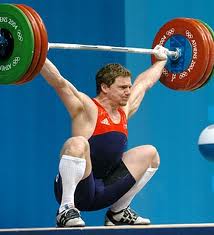
If, however, you're an athlete in a
different sport - or just a general fitness enthusiast - I don't think
they're necessary. And, they may even be problematic if long-term
improvements to your movement quality and health are goals of yours.
I'll explain - but first, we need to understand the two primary reasons
folks wear them.
First, there is the firmness factor.
O-lifting shoes have a very solid heel without "give;" this makes them a
better platform against which to produce force, as compared to normal
sneakers. This firmness isn't exclusive to O-lifting shoes; you'll also
find it in some minimalist shoes, Chuck Taylors, or no shoes at all.
Most powerlifters know this, and it's why they generally lift in "firm"
footwear that allows better heel contact with the floor.
This leads us to point #2...
This leads us to point #2...
There is a prominent heel-lift in these
shoes. I've seen heel lifts ranging from everything from a 0.5 to 1.25
inches. In the sneaker world, however, everything is generally related
in terms of heel-toe drop, or % grade. For a long time, the standard
running shoe was a 12mm heel-toe drop from 24mm (heel) to 12mm (toe),
which creates a 8% grade. The tricky part about interpreting what this
means in the context of Olympic lifting shoes is that I can't say that
I've ever seen anyone list the height of the toe, so we don't really
know the grade. The 0.5 inch lifts are surely pretty moderate, as 0.5
inches equates to 12.7mm, whereas the 1.25 inch ones would be 31.75mm,
which is actually in excess of what you see with the much maligned Nike
Shox (25mm).
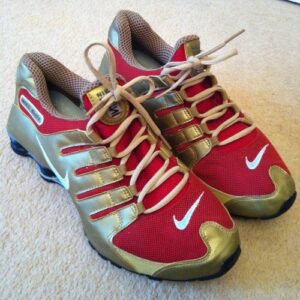
This obviously leads to the question, why
isn't a firm shoe alone sufficient? What's the rationale for the massive
heel lift? Effectively, it's a crutch that helps lifters with mobility
or stability deficits reach squat depth easier.
To squat deep, you need to be proficient on a number of fronts, the foremost of which are:
1. You must have sufficient dorsiflexion range of motion (knee over toe ankle mobility).
2. You have to have sufficient hip internal rotation (can be limited by muscular, capsular, alignment, or bony issues).
3. You have to have sufficient hip flexion
(can be limited by muscular, capsular, alignment, or bony issues; this
typically isn't much of a problem).
4. You have to have adequate knee flexion
(this is rarely an issue; you'd need to have brutally short quads to
have an issue here).
5. You need to have adequate core control -
specifically anterior core control - to be able to appropriately
position the pelvis and lumbar spine. This is especially true if we're
talking about an overhead squat, as it's harder to resist extension with
the arms overhead.
If you lack ankle mobility, you either turn
the feet out, go up on your toes, or rely on the crutch that a heel
lift provides. By elevating the heel, rather than going from neutral to dorsiflexion, you are going from plantarflexed to neutral.
Effectively, it brings you a few yards behind the starting line so that
you don't false start, if that makes sense (if it doesn't, don't worry;
I'll have more on this in the video below).
If you lack hip internal rotation, you turn the toes out so that you're internally rotating from an externally rotated position to neutral, as opposed to going from neutral to an internally rotated position.
I think that we all agree that these
positional changes allow you to make up for a lack of mobility - but
that doesn't mean they're necessary a good thing, as you're effectively
loading an aberrant movement pattern. As Gray Cook has taught us, if you
continue to pile fitness (strength) on top of dysfunction, bad things
happen.
As you may have noticed, I've left out
proficiency #5 from above: you have to have adequate anterior core
control. And, it's because I've saved the best for last; this is a HUGE
issue.
I'm going to let the cat out of the bag and
say that I think we've "over-diagnosed" ankle mobility restrictions.
Most people automatically assume that if they have a poor squat pattern,
it's because they have an ankle mobility problem. I'd estimate that in
90% of cases of people who think their ankle mobility stinks based on a
bad squat pattern, they actually test pretty well when you look
specifically at the joint, as opposed to relying solely on a gross
movement pattern. Why? There is a tremendous interaction between
mobility and stability. In this video, I elaborate:
As further proof of the fact that different
athletes will demonstrate their patterns of insufficient control of
extension differently, check out these four posture pictures of athletes
who had poor squat patterns. In the first, you'll find a pretty
"classic" extension posture that's distributed over multiple joints.
Note the anterior pelvic tilt and lordosis, plus the relatively neutral
knee and ankle positions.
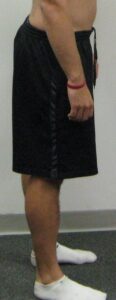
In the second, note the plantarflexed
ankles; this athlete has shifted his "extension compensation" further
down. Do you think he'll have much of a squat pattern with that resting
presentation? He might have perfectly good ankle mobility, but he's
completely unable to shut off his plantarflexors (calves); that's where
he's "finding" his stability.

In this third example, the athlete has
dumped forward at the pelvis and lumbar spine to create what could be
considered a swayback posture - even though his ankles actually look
pretty neutral.
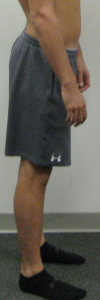
Finally, we'll look more full-body for our
fourth example. Obviously, this athlete is in a heavily extended pattern
through the pelvis and lumbar spine, but note also the positioning of
the arms; his lats are so "on" that he carries his elbow considerably
behind his humeral head, and the scapula dives into anterior tilt.
There's a forward head posture, and while you can't appreciate it well
from this angle, this athlete also had a ton of "tone" in his scalenes,
sternocleidomastoid, and subclavius. He found his stability further up
the chain.
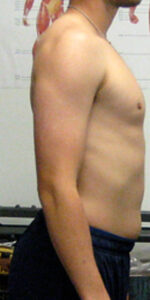
Every single one of these out-of-whack
presentations is a way for the athletes to shift their faulty movement
patterns around to "get by." Athletes are tremendous compensators - but
they all do it differently. I think we can all agree that these are
issues that should be addressed, right? Well, they were - and the
athletes felt a lot better from the training interventions.
How does this relate back to Olympic lifting shoes, though? Well, every single one of these athletes could demonstrate a perfect
squat pattern if I put them in a pair of shoes with this dramatic a
heel lift. It's like giving the most uncoordinated kid in the
neighborhood training wheels...for good. At some point, you've got to
lose the training wheels and learn to ride the bike. And, at some point
you need to stop covering up your poor movement patterns and work to
address them - rather than just loading them - if you want to stay
healthy.
To me, squatting with a pronounced heel
lift is really no different than squatting through a "butt-wink;" they
are both compensations to allow a lifter to maintain the position of the
center of mass within the base of support in the face of a gross
extension pattern. Both fundamentally alter the ideal squat pattern,
though. Conversely, if you use goblet squat or TRX overhead squats to
train the pattern with a subtle counterbalance, though, you're keeping
the movement intact, but reducing the challenge to the lifter.
In folks who have really poor squat
patterns, I'd much rather see them work to improve the squat pattern for
a bit, as opposed to considerable loading of the classic back squat.
While they're working on improving the pattern (through these exercises
and other breathing and core stabilization drills), they can train the
heck out of the lower body with deadlift variations, single-leg drills,
barbell supine bridges/hip thrusts, sled pushing/dragging, and a host of
other exercises. Once their squat pattern has improved, progressing to
a front squat is a great first step, with the back squat coming a bit later on.
With all that said, before I get any hate
emails, let me be abundantly clear: if you move well (i.e., have a good
squat pattern to below parallel in bare feet), then by all means, feel
free to use Olympic lifting shoes for your squatting and Olympic
lifting, if it tickles your fancy. After all, it's only 5-10% of your
training volume, most likely. Just make sure to a) only wear them for
these exercises, b) maintain the underlying "heel-less" squat pattern,
and c) pick the shoes with the smaller heel lift (0.5" instead of
1.25"). You might also consider wearing more minimalist footwear for the
rest of your training sessions to "cancel" the O-lifting shoes out.
And, again, if you're a competitive Olympic lifter, please feel free to
rock whatever you want - and crush big weights doing so.
If, however, you're an athlete in another
sport who uses squatting and Olympic lifting as part of your training, I
don't think it's a useful addition. And, it's certainly not an
appropriate initiative if you are just someone who is looking for a way
to work around your poor mobility. Ignoring a fundamental movement flaw -
and certainly loading it - will always come back to bite you in the
butt.
Source : Eric Cressy

No comments:
Post a Comment